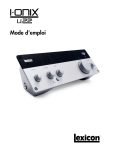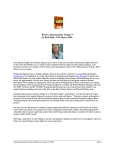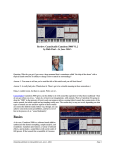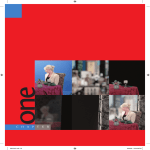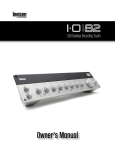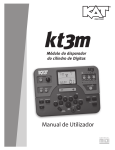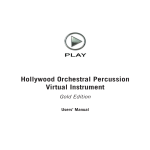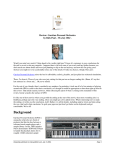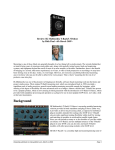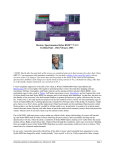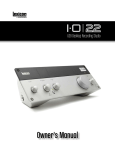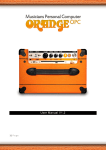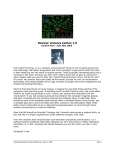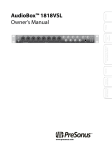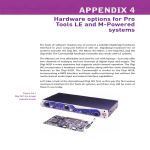Download Review: Toontrack dfh EZ drummer and EZX Expansion
Transcript
Review: Toontrack dfh EZ drummer and EZX Expansion Packs
by Rick Paul - 18th December 2006 -
Toontrack Music initially came to prominence in the DAW world with the introduction of their highly respected
Drumkit From Hell sample set. DFH provided a set of natural acoustic drums and cymbal sounds, with a wide
variety of hits to provide the potential for nuances, and both close-miked and ambient/room mics. The general idea
was to allow the samples to be treated as if they were a set of conventionally recorded drum tracks, leaving
flexibility for DAW users in processing the sounds to suit their needs.
While DFH was critically and commercially successful, the music producers at Toontrack envisioned even more
flexibility and believability than would be achievable using other companies' general purpose sampling engines.
Their second-generation flagship product, DFH Superior (DFHS) could perhaps be described as, "DFH on steroids,"
but that would be a severe understatement. We're talking 35 GB of samples and a custom-developed plug-in that
provides hit randomization for a human-feeling performance, full microphone leakage control for every drum and
mic combination, individual drum choices, stick/beater choices, caching for memory and performance management
of the large sample sets, compression and decompression of samples, and much more. Oh yeah, and then there's the
range of sounds, starting with 5 drum kits, over 60 cymbals, 17 snares, a complete percussion kit, and much more.
As if that weren't enough, a complementary package, Superior Custom & Vintage, adds another 35 GB of samples
aimed at covering classic drum sets in a similar manner.
One could think of DFHS as one candidate for the ultimate softsynth for creating realistic acoustic drum parts. The
sounds are top notch, and the control possibilities are on par, or possibly even superior, to what you'd get with
multiple mics and real acoustic drums. With the right performance, and care in your processing of the sounds, you
could create extremely realistic recordings, or have the flexibility to mangle things to your liking for that matter.
However, this "everything you could possibly ever want to do" sort of approach has one major drawback, which is
actually somewhat inherent in its very strengths: It is fairly complex to set up and use.
That's right, believe it or not, as much as most of us think we want the kinds of detailed control capabilities a
product like DFHS provides, we also often want to just get to work building drum parts. We don't always want to
have to concern ourselves with things like which drums to use in our kit, which drums should bleed into which mics,
rendering parts and importing audio to work around real RAM limitations when using huge sample sets, and so on.
Wouldn't it be nice if we could get the same kind of sound quality and realism, but in a package that makes it easy to
get going, from drum kit building, to rhythm programming, to handling multiple mic considerations and mixing?
(Cue dfh EZ Drummer entrance.)
Depending on your perspective, you might think of Toontrack's dfh EZ Drummer, which we'll refer to as "EZD" for
short, as either an entry-level version of DFHS or an enhanced, or next generation, version of DFHS. In truth, it is a
Originally published on CakewalkNet.com, December 18, 2006.
Page 1
bit of both, while also being complementary to DFHS. In this review we'll be taking a detailed look at EZD, as well
as three recently-introduced EZX expansion packs that modularly add onto what you can do with EZD.
Background
Toontrack's dfh EZ Drummer is a multi-microphone, sample-based acoustic
drum module plug-in, which includes an extensive, and extensible, MIDI
drum groove library. EZD features a highly intuitive visual interface,
including drag and drop integration into most modern DAWs. According to
Toontrack, EZD is, "designed for musicians and producers in need of a
compact, affordable, easy to handle plug-in without compromising sound
quality or control."
EZD's sample set includes 7,000 sound files at 16-bit, 44.1 kHz, equivalent to 5 GB of uncompressed WAV files.
However, Toontrack's proprietary TPC II compression is used to reduce system requirements to a minimum, both in
terms of disk space consumed and memory footprint. Only 1.5 GB of available disk space is required for EZD itself,
with each of the optional EZX packages adding 1 GB apiece if purchased and installed. A typical EZD or EZX drum
set consumes on the order of 250 MB of RAM, plus or minus a bit. Nevertheless, EZD features the same extensive
layer depth on all drums and cymbals as DFHS.
The basic kit shipped with EZD is a modern-sounding kit that should easily find a home in pop, rock, and
contemporary country productions, among others. You won't find brushes, or percussion instruments that aren't part
of a basic drum kit. You will, however, find multiple kick drum and beater options, multiple snare drum options,
and, in fact, a minimum of two options for each of the nine kit components (kick, snare, three toms, hi-hat, and three
cymbals). The basic EZD package also includes an initial EZX expander, EZX Cocktail, which adds a small kit
suitable for cocktail lounge-type music. It includes a kick drum, snare drum, two toms, hi-hat, and ride cymbal. Each
of the optional EZX packages adds its own kits of varying sizes to those available in EZD. We'll get into more detail
on each of those when we discuss those optional packages below.
EZD allows sending each of its microphones to separate audio outputs, thus allowing for processing at the DAW
level, including using different plug-ins on each virtual microphone. However, it also provides a mixer control that
makes it easy to submix EZD to a single stereo output pair. In this case, EZD also provides preset mix modes that
make it easy to create well-mixed blends if you don't need to process the drums individually or just want to mock up
something quickly for a demo or rough mix, then worry about refining things later.
EZD ships with a library of more than 8,000 drum patterns, and it is also possible for users to extend the library by
adding their own, or third party, MIDI files. Each optional EZX pack also adds more drum patterns to the EZD
library. While EZD's native mode of operation includes the same sort of extensive mapping used in DFHS to allow
fine nuances in the playing, General MIDI operation is also supported for ease of integration with third party MIDI
sequences. EZD's groove browser makes it simple to preview any grooves from EZD's library in context within your
DAW, and it is a simple matter of dragging and dropping any groove from EZD to the DAW's MIDI track area to
program a drum sequence once you've found the most appropriate pattern. Of course, this is MIDI data, so it can
easily be edited from there, if need be.
The optional EZX expansion packs available at this time include the Latin Percussion EZX, Drumkit From Hell
EZX, and Vintage Rock - Brushes and Sticks EZX. Latin Percussion EZX provides 25 different Latin and ethnic
instruments, some with multiple options (e.g. there are 11 different tambourine options!), along with an extensive
library of grooves oriented primarily toward use of these instruments in rock, pop, and jazz sessions. Drumkit From
Hell EZX recaptures the nature of Toontrack's original DFH, which was oriented primarily toward heavy metal
drumming. It combines the instruments and grooves from the original DFH plus the Add-on Pack that was
subsequently released for that product, though all sounds were remixed for the EZX version. In addition to a double
kick, snare, hi-hat, and 5 toms, there are 11 different cymbals, and most of these individual instruments have
multiple choices for the specific component to be used. Vintage Rock - Sticks and Brushes EZX primarily captures a
historically important Ludwig set with Zildjian and Paiste cymbals, though there are a few, similarly historically
Originally published on CakewalkNet.com, December 18, 2006.
Page 2
significant, non-Ludwig snare options. The kit for this EZX includes a kick, snare, two toms, hi-hat, and three
cymbals, each with multiple choices of instrument. There are also choices of beaters for the bass drum, and sticks
and brushes for other instruments.
List price for EZD is $179 (USD), with the best street price I found at the time of this writing being $159. This
includes a DVD with VST and AudioUnits plug-ins -- an RTAS plug-in is now available via download to registered
users. There is also a PDF manual and a printed license agreement, but no paper manual. A Flash tutorial is available
on-line. Each of the existing EZX expansion packs lists for $89 (USD) apiece, with the best street price I found
being $79 apiece.
All testing for this review was carried out with SONAR 6.0.1 Producer Edition on an Athlon XP 1600+ computer
with 1 GB RAM running Windows XP SP2. Some of my early use of EZD was also carried out under SONAR 5.x
and SONAR 6.0. There is at least one important operational difference in the drag and drop operation between
SONAR 5 and SONAR 6, which I will mention when we get to the applicable section of the review.
Getting Started
Installing EZD was a relatively simple matter, though by no means as automatic as popping in the installation DVD
and answering a few questions. You do have to look for the "Read Me.txt" file in the top directory of the DVD to
find the high-level installation instructions, which simply say:
To install simply run the installers for your platform located in the 'install' folder. Additional instructions
can be found in the Operation Manual situated in this directory. A PDF viewer is required to access the
documentation.
Under the "Install" folder are two folders, "Mac" and "PC". Going to the "PC" folder for my Windows system, I
found two ".msi" (Microsoft Installer) files, "EZdrummer Installer.msi", to install EZ Drummer itself, and "EZX
Cocktail Installer.msi", to install the included Cocktail EZX package. The referenced Operation Manual does give
somewhat more detailed instructions, but this having to find your way to the installation files might provide a minor
stumbling block for truly computer-phobic types.
Once you get the EZD installer running (and it is important to run that one before the Cocktail installer), it will
prompt you for paths and such, and things are extremely straightforward from that point. You do get the choice of
installing the software and library in different locations, but all EZX packages will have their libraries installed in
the same location as EZD's library, so this may be something to be aware of when considering potential future disk
capacity needs. Once you have installed EZD, the EZX installations become fairly trivial since the installers already
know where to locate the needed files by virtue of the EZD installation. This is also why it is critical that EZD is
installed prior to installing any EZX packages.
Authorization is required to run the EZD software. The first time you run EZD, you will be prompted to authorize
the software. If your DAW is connected to the net, authorization is a simple matter of entering some information
into a screen, then copying and pasting the authorization code. I can't imagine not having my DAW connected to the
net due to considerations of registering software, getting upgrades, and so on. However, for those who don't,
Toontrack does allow authorizing EZ Drummer from another computer by typing in the relevant information from
both sides of the authorization process. I have heard a few accounts of issues in this area. These most likely arise
from a special consideration of the authorization process where your network state on the EZD computer must be
the same (i.e. either on the net or off the net) when you get the authorization information as when you authorize the
software. I assume this means network state must somehow figure into the computer ID used in the authorization
process. This would most likely be an issue for DAWs that are sometimes on the network and sometimes not, as
opposed to DAWs that are either always on the network or always off the network.
Using EZD as a VST instrument within SONAR starts out with inserting an instance of EZD in SONAR's Synth
Rack. There is one decision to make at this point, and that is whether you want to use EZD's individual outputs or its
Originally published on CakewalkNet.com, December 18, 2006.
Page 3
mix output. Using individual outputs give you the flexibility of using separate plug-ins to process each virtual mic
(or mic pair in some cases). For example, you could use different
compressors on the kick and snare. If you don't need to do that, though, using
the stereo mix output makes for quick work since there are some very useful
mix presets within EZD to correspond to common situations. What you
choose here is mostly a matter of convenience since you can always add or
delete tracks later on if you change your mind on what is needed. Personally,
I tend to start out with just the stereo mix. I find I can get things most of the
way that way, simply using EZD's mix presets, perhaps with a few minor
tweaks of my own, to get a nice submix of the drums, with minimal clutter in the form of extra tracks. This will get
me all the way through programming my drum parts, and I'll only need to create additional tracks if I choose to do
separate processing of the virtual mics come mix time. Whether that separate processing is necessary, even in a final
mix, will depend on the needs of the song. Keeping things simple, or should I say, "EZ," on the front end makes for
nice workflow economy.
Once you've made your output choices and let SONAR insert the plug-in, the
EZD interface will open and load the default drum kit. This takes a few
seconds as the kit weights in at approximately 267 MB. This automatic
loading is a mixed blessing. On the one hand, if you will be using the default
kit, which is well suited to pop/rock and similar forms of music, this
automatic loading gets you ready to go with a minimum of fuss. Being able
to get down to working quickly is one of the major benefits of EZD in
general, and this approach makes sense in that light. On the other hand, if
you were planning to use another kit, for example from one of the EZX
expansion packs, this may slow you down slightly. However, the good news
is that, even in the latter case, you can simply select another expansion pack from the list of those near the top center
of the screen. The default kit loading will be interrupted immediately to begin loading the default kit from your
preferred expansion pack. What if that isn't what you wanted either? For example, what if you wanted another kit
from your preferred expansion pack? No worries, because you can also interrupt the loading of that kit to load your
preferred kit. To avoid complicating things for the moment, let's defer on the details of that until a bit later.
Assuming you did go with the default pop/rock kit, what you will have at this point is a kit configured nicely for an
ambient, but not overly so, stereo submix. If that's not what you want, you can tweak from there, for example to
change to a multi-out configuration, change the level of ambience or blend of the individual mics, select different
drums for kit components, and more. We'll get into the options in more depth below.
You also get a nice visual indication of the basic drum set you're using, though that is not specific to individual drum
choices within the overall kit. That visual indication goes beyond being just a good-looking, if somewhat large, user
interface. It also provides a highly intuitive interface for checking out the sounds of individual kit components,
changing kit components, and showing you which kit components are being used when EZD is played via MIDI.
At this point, if you don't need to tweak the setup, you are ready to get down to work creating a drum part. Just to
recap, what we're talking about here is less than a minute of time from deciding to insert EZD into SONAR and
having a fully loaded, nicely balanced multi-miked acoustic kit ready to go. Try doing that with real drums, or even
many other drum samplers!
As for creating that drum part, there are three basic options. Those options are not necessarily mutually exclusive.
First, if you happen to be a drummer, or at least good enough of one to play the part needed for your project, and
have a set of drum triggers, such as Roland V-Drums, you could just "play" EZD using your drum controller. I'm not
a drummer, and don't have a set of V-Drums, or even a less-capable drum set controller, but I've heard some real
drummers rave about EZD in this scenario. Why would a real drummer want to use EZD, rather than just recording
a real drum kit? I'll refer you back to the last sentence of the previous paragraph for a start, but then there's the
consideration of mic quality, drum quality, recording techniques, and, oh yeah, neighbors. Of course, you also don't
need a real drum controller to play EZD via MIDI. Any MIDI controller, including a keyboard, would do.
Originally published on CakewalkNet.com, December 18, 2006.
Page 4
Second, and perhaps the most likely scenario for those of us who aren't drummers, is using EZD's built-in library of
drum grooves to audition grooves against your project. As you find grooves that are appropriate, you can drag and
drop those grooves into the appropriate locations within the MIDI drum track driving EZD within your project.
We'll talk more about EZD's groove library browser below, but it is also worth mentioning now that EZD's groove
library can be extended with third party MIDI files. Thus, EZD's convenient browsing interface isn't limited to use
with EZD's own groove library.
The third option is simply driving EZD with MIDI loops or programmed MIDI parts that do not originate within
EZD's groove library or by being recorded manually as MIDI tracks in your project. Since EZD does provide
General MIDI compatibility, it is easy enough to take most any third party MIDI groove library and use EZD as the
sound source. Of course, you can also painstakingly program the parts by creating them in one of SONAR's MIDI
editors, be it by drawing in the notes individually, using the pattern brush, or however you might prefer to create
parts.
As I mentioned above, these options are not mutually exclusive. For example, you could rough out a part using
EZD's groove library, then edit the parts generated manually to better suit your project. Or you could program the
basic beat using EZD and manually play some drum fills from your favorite MIDI controller. The bottom line is
EZD doesn't tie its groove browsing capabilities to the sounds generated. Even if you are programming your parts
with EZD, the programmed parts end up being independent MIDI tracks, not slices of audio loops as with many
loop-based drum modules. The groove library is simply a convenience for getting great sounding results, played by
excellent drummers, out of EZD without having to be a drummer yourself. Similarly, EZD's sounds can be used just
as easily whether you're using them with EZD's groove library, third party MIDI libraries, or grooves you've played
or programmed yourself.
The basic idea here is simply to get up and running quickly, with the best interface into EZD being the one that is
most comfortable for you. However, your choice of operation method may make a difference in whether you find
EZD to be evolutionary or revolutionary with respect to how it affects your workflow. Let's dive deeper.
Kits, Drums, and Cymbals
If EZD's default kit, or the default kit of one of the EZX expansion kits, is right for your project, you are ready to
start building drum tracks at this point. We'll talk about that in the next section. However, if you want something
slightly different, be it a different kind of kick drum beater (e.g. felt versus plastic), a different snare drum or
damped version of the default snare drum, a different sized tom or size and brand of cymbal, or, possibly with some
expansion packs, different drum sticks (e.g. brushes versus sticks), it can be helpful to make these choices prior
starting your programming. This is especially true if you are creating your parts by manually playing a MIDI
controller, as the feel of the sounds that emanate from your playing can be quite different with different choices, and
that can affect your playing. Even in the case of using groove libraries, though, the sounds may affect your choice of
groove.
To select a different option for any given drum or cymbal (or percussion
instrument in the case of the Latin Percussion EZX), click on a popup menu
control on that instrument. The top entry in the menu shows the name of that
instrument (e.g. "Snare", "Tom 1", "Crash B", etc.). Just below that are any
specific choices for the instrument. For example, in the default kit, there are
six total choices for the snare drum. These are damped and undamped
versions of three different snare drums: a 14" Rogers snare, 14" Slingerland
snare, and 13" GMS Piccolo snare. With kick drums, the distinctions are
most frequently between types of beaters. Cymbal and percussion choices
often cross brands, sizes, and models.
Toward the bottom of this same popup menu are any global kit preset choices
for the specific sample set. For example, with the default pop/rock sample set
that comes with EZX, these choices are default kit, tight kit, ambient kit, and basic kit. With the included Cocktail
Originally published on CakewalkNet.com, December 18, 2006.
Page 5
EZX, the choices are default kit (damped brushes), open brushes, sticks, and none (i.e. you'll need to select each
drum manually). These choices affect multiple instruments within the kit, but not mixer settings. The idea is to
quickly put together a matched kit, at least from Toontrack's perspective, while giving you the possibility of
overriding individual instrument choices to suit your projects needs.
The basic method of operation here is to select the kit preset that most closely approximates your needs first, then
make any individual instrument overrides, if necessary. Note that any changes you make, be they at the kit preset
level or the individual instrument level, will cause some changes in sample loading. The overall amount of memory
consumed by the kit may go up or down, depending on how the sizes of your new selections differ from those of
your default selections. I mentioned earlier in this review that the loading of the default kit when EZD is loaded may
slow you down slightly. It is only slightly, because you can use these same popup menus immediately to select the
kit presets, and/or individual drum choices, you prefer. When you do that, EZD immediately stops loading the kit it
had been loading prior to your choice, and starts making any changes called for by your choices. It also appears to
be intelligent enough to not unload instruments that were already loaded in cases where your new choices don't
change some of the previously loaded instruments. Of course, if your new changes change everything, then it will go
back to square zero.
Get Your Groove On
At quick glance, EZD's groove browser is reminiscent of the similar function
in Spectrasonics' Stylus RMX. The high-level visual setup distinguishes four
levels of organization, starting at the library level and going down to the
individual groove, or groove variation, level, and clicking on any groove
while previewing plays the groove whose name you just clicked. That is
where the similarity ends, though.
First off, appearances can be deceiving. Where RMX adheres to a rigid 4tiered organization scheme, EZD's organization scheme can include less, or more, layers of organization than the
four parallel panes of the browser window might imply. In the leftmost pane of the browser, you select the groove
library. Those libraries are subgrouped into EZD libraries (i.e. libraries that come with the basic EZD package),
EZX libraries (i.e. libraries that come with either the included Cocktail EZX or one of the optional EZX packages),
and user libraries (i.e. libraries you've either created yourself or acquired from third party MIDI loop developers).
Each of the libraries is listed in the browser pane, which allows changing libraries very quickly when you need to do
that. There are no menus to pull down. What is in the next pane varies according to the library. For example, in the
simplest case, the EZD Demos library, the next pane directly links to the grooves constituting the demos, so clicking
on one of those will directly play the demo if previewing is engaged. In one of the most complex cases I noticed,
from the EZX Drumkit From Hell library, the second pane is sub-divided into three families of styles (i.e. Metal
Straight 4/4, Metal Straight 4/4 Triplets, and Other Stuff), and each family of styles has sub-families (e.g. under
Metal Straight 4/4 Triples, there are Double Kick, Double Kick Backbeat, and Fills, among a number of other
choices). In that same example, choosing a sub-family (e.g. Double Kick Backbeat) opens up a third pane, which has
multiple "grooves", in some cases, sub-categorized, for example by tempo ranges (e.g. 130-180 BPM and 100-145
BPM in this example). Picking a groove then opens up a fourth, and final, pane with the actual groove loops, or
"instrument variations" as EZD labels them. These are playing the same basic groove, but with variations in the
instrumentation. For example, one might use ride cymbals while another uses ride cymbal bells and another uses
open hi-hats, or one might have ghost notes in the snare part and the other might not. And there might be various
permutations of these variations. The idea is to get you to a basic feel, then let you find just the right variation of that
feel for the part of the song you are trying to cover. If you were counting, this specific example had six levels of
organization (i.e. library, feel family, style sub-family, tempo family, groove, and instrument variation).
While varying levels of organization, different types of categorization within different libraries, and so on sounds
like it could be confusing, it really isn't when you sit down to find patterns. The general goal seems to be to help you
find the quickest sensible route to what you're seeking, and rigid layers of organization aren't always the most
suitable way to achieve that. Additionally, clicking on an entry that results in another pane's opening gives instant
results, even with imported third party groove libraries. Thus, browsing is lightning fast, and this translates to being
Originally published on CakewalkNet.com, December 18, 2006.
Page 6
able to hone in on a beat you can use far more quickly than even RMX can do. This is because you aren't changing
audio samples when you switch libraries or grooves. The samples are already loaded in the drum kit, and all you're
changing is the notes you are sending it. Also, EZD has taken on the task of making sure you can move between the
various layers of organization rapidly, so all you have to worry about is reading names and clicking on the ones you
want to try.
Like RMX, EZD has a "Play" or "preview" button to determine whether playback is engaged, and whether clicking
on a groove name (or instrument variation) starts playback of that groove. There is only one layer of grooves in
EZD, though. This simplifies things greatly in terms of user interface considerations, but does mean that, if you want
to, for example, build a Latin percussion part on top of a drum set part, you will need two instances of EZD. And, if
you want to build multiple layers of Latin percussion parts, such as an agogo layer and a conga layer, and you are
starting from grooves for the individual parts, you will need to have dragged and dropped one of the layers to your
project's MIDI tracks so that can be playing back while you are previewing the potential grooves for the second
layer. Whether this layering consideration is an advantage or drawback will depend on your preferences in working
style. I certainly don't find it a disadvantage when it comes to building basic drum tracks, and it would be unusual
for me to build Latin percussion tracks at the same time as the underlying drum tracks -- I usually treat any
percussion parts as overdubs. However, it could be less convenient when trying to build up a Latin percussion track
where the interplay of different instruments is important to defining the overall beat.
Perhaps the most important difference from RMX, and many other drum modules for that matter, is that, with EZD,
you can switch grooves, families of grooves, styles, and even libraries, while the drum kit, and its processing,
remain consistent. This is a very important consideration when it comes to wanting to maintain a consistent drum kit
sound throughout an entire song while subtly, or even radically, changing the rhythmic feel. Whereas, in audio loopbased systems like RMX, even changing beat families might get you a drum kit that is radically different from the
one you were using. That may be desirable in some contexts, but not when you're trying to give the impression one
drummer is playing the same acoustic drum kit in the same environment for an entire song. This is, of course, due to
EZD's making a clear separation between the rhythms driving it and the actual sound source, even if the efficient
integration of EZD's browser into its main user interface gives the appearance of a tightly-coupled system.
While each EZX provides its own library of grooves, and those libraries are optimized for the sample set of that
EZX, there is nothing saying you can't mix and match. Just be aware that, while basic mappings are compatible from
sample set to sample set, with the key exception of Latin Percussion EZX, which is a whole 'nother animal from the
drum kit-oriented modules, you can't expect 100% mappings. For example, the Cocktail EZX has a total of 6
instruments (hi-hat, cymbal, and four drums). The DFH EZX has a whole bunch more, including 11 cymbals alone!
You can't expect a groove that extensively uses the DFH kit to translate well on the Cocktail kit, though going in the
other direction (i.e. using a Cocktail groove on the DFH kit) will probably do just fine, albeit providing a very
different character than it would have on the smaller kit. Similarly, anything programmed for the Latin Percussion
EZX will likely produce unpredictable results on any of the drum kit EZX modules, and vice-versa. Of course, those
unpredictable results might well lead to happy accidents.
The built-in EZD groove library is quite extensive, and each EZX expansion pack adds on from there. However,
Toontrack has thoughtfully left EZD's library open to further expansion, be it from third party MIDI loop libraries or
from loops you program yourself. I won't get into the nitty-gritty details of how to integrate outside MIDI loops into
EZD. The basic gist of it, though, is to create your own subdirectory structure in the relevant directories underneath
the EZD file structure, naming them as you see fit for your sub-organization purposes. Up to three levels of
directories are supported. The groove names themselves come from the MIDI files.
At least one third party MIDI library developer, Groove Monkee, makes it easy on EZD users by having done the
integration and organization work themselves. This makes it a simple matter of extracting their loops in the right
place within your file structure to have them appear as grooves within EZD. This is a very nice touch in that it adds
value to both products. It provides a wealth of additional groove options for EZD, while making Groove Monkee's
loops much easier to use with EZD through the tight integration of EZD's browser.
Okay, so you've picked a groove from one of the many available to you from EZD itself, one of the EZX packs, or a
third party library you've integrated with EZD. Now you want to put that loop in your project at the right point in the
Originally published on CakewalkNet.com, December 18, 2006.
Page 7
song. It is a simple matter of dragging the groove from EZD to the appropriate point in your project. Note that you
may want to turn SONAR's quantization grid on first, setting an appropriate value for the type of groove you're
dragging (typically a measure for full measure grooves, but perhaps another increment for fills). Once you've done
this, the groove shows up as a MIDI clip in SONAR. This is one area where you'll see a slight difference in SONAR
5 and SONAR 6. In SONAR 5, the MIDI clip shows up unnamed. If you want it named relevantly, you'll need to
rename it yourself. In SONAR 6.0.1, though, the MIDI clip gets a name that bears some relation to the groove. It
may not, however, be the actual name of the groove. In some cases, such as with the Groove Monkee loops I
checked, it was. In other cases, though, it was something that looked somewhat like gobbledygook. One example I
dragged from EZD's pop/rock library came out "EP_P_G01_01H". As best I can make it out based on what I
dragged, this translates to the EZD Pop/Rock Library, Pop/Rock family of grooves, Groove #1, playing variation 01,
with the trailing "H" probably meaning "hats". The actual groove name in EZD was "01. Hats 4th Hard Closed".
Interestingly, the name also did not come directly from the underlying MIDI file name, which was
"A@01._Hats_4th_Hard_Closed.mid". I didn't find anything obvious by loading the MIDI file itself directly into
SONAR, either. Thus, I can only speculate that EZD and SONAR are talking somewhat different languages in
something related to the dragging and dropping of EZD and EZX grooves between EZD and SONAR. The net is,
you may still want to manually rename grooves on the SONAR end, even in SONAR 6. It would sure be nice if
Cakewalk and Toontrack could somehow get synchronized on protocols in this area, though.
Overall, though, EZD's browser, and the drag and drop of grooves to SONAR, provides a highly efficient
environment for building drum tracks from MIDI loops in SONAR. It may not be as big a deal to users of other
DAWs, such as Cakewalk's own Project5 V2, that already feature preview of MIDI loops through softsynths in their
loop browsers. However, SONAR is notably lacking in this feature, which has historically made building MIDI
loop-based parts a bear because you have to drag the loop in, back up and listen, then undo it and start again if the
loop isn't just what the doctor ordered. With EZD, SONAR/EZD users won't have to be doing that for building
acoustic drum parts anymore.
Mixing It Up
Somewhere between the time you insert EZD in your DAW and the time you
render any final drum tracks, you're likely to want to visit EZD's mixer
section. While EZD's default settings are very reasonable for just getting up
and going quickly, and may even suit many projects, odds are pretty good
you'll at least want to experiment a little here before committing to use of the
default settings.
EZD's default settings come preconfigured for use of the stereo outputs. Thus, one obvious need for visiting the
mixer will be if you intend to use multiple outputs, in which case you'll want to reroute the various mics to whatever
individual output configuration you prefer. If this sounds like it could be tedious, don't worry. EZD also provides
track routing presets, and one of those is called "Multichannel". Choosing that preset reroutes EZD's mic
assignments to the most likely configuration for the type of kit you have configured. For example, with EZD's
default kit, the Multichannel preset routes the kick to track 1, snare top to track 2, snare bottom to track 3, hi-hat to
track 4, a stereo submix of the three toms to track 5, overheads (stereo) to track 6, and room (stereo) to track 7. I
should note that, while only the overhead and room mic configurations are inherently stereo, all track outputs are
stereo. The default routing for the hi-hat pans it in a way that takes advantage of this. If you want a hi-hat panning
that is different from what EZD picks, you can either pan the hi-hat mic differently within the EZD mixer, or center
its pan position within EZD then use SONAR's track level panning to get the placement you prefer. EZD only has 8
outputs, so you will need to do some submixing within EZD for kits that have more than 8 mics. (Note: My use of
"8 mics" here is a slight misnomer. I am counting the overhead and room mics each as a single stereo mic, though
they may well have each used two mono mics. The key is that these mic pairs only have a single fader control within
the EZD mixer. However, there are also separate panning controls for each of the mics in the pair.) There is another
track output preset called "Single" which routes all mics to a single stereo output. Of course, you can manually route
each of EZD's mics (or mic pairs) to whichever of EZD's eight outputs you prefer.
Originally published on CakewalkNet.com, December 18, 2006.
Page 8
As you might expect from the control's name, the most visible features of EZD's mixer are the faders. There is one
for each mic (or mic pair). There are also panpots to pan the mono mics and each side of the stereo mic pairs. The
snare bottom and overhead mic channels also have a switch to turn bleed into those mics from other mics on or off.
Mixer presets, which effect fader and pan positions, as well as the mic bleed switches, but not output configurations,
are also available. For example, in the default kit, these presets are named "Default", "Roomy", "Dry", and
"FlatMono", and these adjust the relative balance to, for example, bring in more or less of the room mics. All the
presets configure the drum set from drummer's perspective for a right-handed drummer (i.e. hi-hat on the left).
However, there is also a handy pan reverse button to instantly invert the positions of all pan controls to change to
audience perspective (or left-handed drummer's perspective).
One decided omission in EZD's mixer is automation. In fact, none of EZD's controls are automatable at this time.
This is not the end of the world for the mixer, though. If you need to automate mixer controls, simply use separate
outputs, then automate the DAW-level controls instead. There are only a few scenarios where this could be a slight
compromise. In particular, if you are in the position of using too many mics for EZD's eight outputs, thus having to
submix some of the outputs, you would not be able to automate the blend going into the submix, only what is
coming out of it. If you don't need to automate all mics, though, you may be able to adjust your submix strategy to
separate out the ones you will need to automate.
A Bit of Extra Humanity
EZD features two additional controls that are somewhat hard to categorize,
but both of which contribute to making EZD's parts feel a bit more human
than they might otherwise feel. Just below the left side of the Groove name
box in the lower center portion of the EZD user interface is the "Humanizer",
or hit randomization, button. (Don't be confused by its knob-like appearance.
Despite that, it functions as a toggle button.) If this is turned off, and you send EZD the same MIDI note, at the same
velocity, a number of times in succession, you will hear the exact same sound each of those times. A machine can do
this, but a human drummer would be highly unlikely to hit a drum so consistently. If you turn the Humanizer button
on, though, EZD subtly varies each hit, so you get a much more human-sounding result. The EZD Operation
Manual provides the following advice regarding the Humanizer button:
A great feature of EZdrummer is the Humanizer. It makes life creating drum tracks so much easier that
turning it off is a shock to the system. Still if you prefer your track machine-like we won’t stop you!
That just about says it all. I really can't imagine ever using EZD without this function engaged. While the details of
how it works may be subtle, the end result is anything but, especially if you're working with programmed, as
opposed to human-played, MIDI loops.
Over on the right side of the same area of EZD's user interface is a velocity sweep knob. In its default, centered
position, EZD's plays the velocities the MIDI sequence driving it issues, with the exception of any modifications
made by the Humanizer control. If you turn the knob to the left or right, though, EZD scales the velocities down or
up, respectively. Thus, your drummer can have a lighter or heavier touch than that of the MIDI sequence it is
playing. This can help adapt a stock groove to the needs of your song. The one key disappointment here is that this
knob is not automatable. It would be very useful, for example, to be able to turn the knob a bit down during quieter
sections of a song, then turn it up to emphasize other sections. Without automation, the only way you could do this
would be to play the knob live while routing your EZD's audio outputs directly to some of your DAW's audio
outputs, then routing those back, be it via cables or audio card-level mixer facilities, to your DAW's audio inputs for
recording on new audio tracks. Hopefully Toontrack can add automation of this feature in a future EZD update.
Drumkit From Hell EZX
Compared to the basic, mainstream-oriented drum kit in EZD, and the smaller lounge-oriented kit provided in the
included Cocktail EZX, the Drumkit From Hell EZX may feel excessive. We're talking 11 Sabian cymbals (with
Originally published on CakewalkNet.com, December 18, 2006.
Page 9
multiple choices for all but two of those) and 5 Sonor toms, alongside
multiple snare and kick drum choices, including the possibility of a double
kick drum configuration. You can check out the full instrument list on the
EZD web site, but suffice it to say this is one massive kit. As you might
suspect when noting kit preset styles with names like "Metal Kit", "Thrash
Kit", and "Death Kit", the DFH EZX is aimed squarely at heavier rock styles.
In addition to featuring two extra tom channels (i.e. compared to the EZD
default kit) in the EZD mixer, the mixer for DFH EZX includes a (stereo) compressed mix channel. Blending a
compressed mix of the drums in with the main drum mix is a common studio trick for beefing up the drum sound in
a recording. Having this capability right in EZD when using the DFH EZX provides a nice convenience, especially
when working with EZD's stereo outputs and wanting quick results.
The grooves added by the DFH EZX tend toward the fast and the furious. There are plenty of double kick drum
grooves, as well. I didn't count, but there are a boat load of grooves in this collection, categorized at the high-level
by feel to help hone in quickly on possibilities. There are also a number of special purpose grooves in an "Other
Stuff" category. That category includes subcategories with names like "Tom Stuff", "Cymbal Chokes", and "Ride
Stuff", among others.
Vintage Rock Brushes and Sticks EZX
While the DFH EZX goes toward the heavier side of things, the Vintage
Rock - Brushes and Sticks EZX goes more mellow, and retro. The Vintage
Rock EZX kit is based on a 1960's vintage Ludwig kit popularized by Ringo
Starr of the Beatles, with a couple of snare drum alternatives, including one
popularized by Led Zeppelin's John Bonham. The kit is much more modest,
as well, with only a single rack tom in addition to a floor tom, snare, kick, hihat, and three cymbals. You can find the complete instrument list on the EZD
web site.
Beyond the character of the kit, the big news is the choice of brushes or sticks for two of the snare options, and a
low tuning with sticks for one of them. The mixer in this EZX includes a compressed room channel for mixing in
with the various mic channels.
The Vintage Rock EZX groove library is organized quite differently from both EZD's default library and the DFH
EZX library. High level groupings sub-organize things into tempo classes (e.g. slow, medium, fast), alongside a few
special purpose groupings like odd time signatures, shuffles, and extras. Within the main sub-groupings are styleoriented groups like "Rock", "Funky", "Jazzfusion", and "Double Tempo Rock". The odd time signatures grouping
is organized by time signature (i.e. 3/4, 6/8, 5/8, 7/8, and 9/8). The extras included brush snare swirls and cymbal
FX. This is all within the second pane of EZD's browser. Once you move to the third pane, you get into what I
would call "designer subcategories" in most of the categories. These names tend to hint at the artist or song with
which the grooves in the subcategory are associated. A few examples include "50 Ways", "About to Rock", "BBoys", "Ballroom", and plenty more. Not all names are of this sort, though. Some are a bit more style-oriented, such
as "Disco", and the extras categories get right down to business, putting the actual groove loops in the third pane.
For the designer styles and functional styles, though, each subcategory will list multiple numbered grooves (or
"fills" in some cases), and, upon selecting one of those, the fourth pane opens up to display the actual loops. In most
cases, the number of variations on the grooves is much more limited than in either the basic EZD Pop/Rock library
or the DFH EZX library. For example, a typical pattern is to have up to three variations for hi-hats (closed, half
open, and open), up to three variations for ride cymbals (ride, edge, and bell), and a tom groove. If you happen to
"get" the designer name clues, this naming style can be very useful. If not, it might feel like it makes things more
confusing on the front end. Over time, though, it probably beats a much larger category without named
subcategories, thus simply giving a huge number of generically named grooves (e.g. "Groove01", ..., "Groove35")
like in the main EZD library.
Originally published on CakewalkNet.com, December 18, 2006.
Page 10
Latin Percussion EZX
Unlike the basic EZD package and the other EZX packs, the Latin Percussion
EZX isn't focused on a drum kit, but rather on a fairly comprehensive set of
individual percussion instruments. You'll find everything from extremely
common instruments for any style, such as tambourine and cowbell, to
backbone instruments for a Latin percussion section, such as congas and
various types of shakers, to more esoteric entries, such as an udu and a
waterfall. You can find the complete instrument list on the EZD web site.
There is one highly curious omission, though. There are no claves included,
and claves tend to be one of the most common instruments found in Latin percussion sections. There are
woodblocks, and they can serve a similar purpose, but it's not quite the same thing, though the grooves provided for
the woodblocks do include some common clave beats. In this EZX, a number of the instruments do not have
multiple choices (e.g. for brand and model), but simply "none" or the particular instrument that Toontrack has
chosen. The "none" choice may be valuable here to save memory if you don't need all 26 instruments loaded for
your song.
The mixer section for the Latin Percussion EZX has individual mono channels for most instruments, but includes
stereo channels for the room mics and multi-drum instruments (i.e. congas, timbales, and bongos). Those multidrum instruments are also the only instruments that include the toggle switch to incorporate leakage from other
microphones. (Of course, the room mics will also include all instruments.) As you might expect with the number of
instruments in this EZX package, the multichannel track output configuration preset uses all eight of EZD's outputs,
and there is still some submixing that is required. Of course, if you don't like its choices of default submixing
configurations, you can change those.
The groove library that comes with the Latin Percussion EZX has its second browser pane organized first by
instrument type (e.g. congas, cajon, bongos, etc.) and then by type of styles or rhythmic classes. So, for example, if
we look at the congas, some of the stylistic categories provided include Tumbao Straight, Tumbao Swing, Bolero,
Martillo, Rumba, Samba, and so on. Depending on the stylistic category, the individual grooves may be in the third
browser pane, or the third pane may be used for another layer of organization. For example, with rumba beats for the
congas, the third pane gets right to the grooves, with multiple variations available. Whereas, with straight tumbao
beats, there are multiple subcategories of one and two conga beats with different feels, each with multiple groove
categories within them, then you get to the fourth pane which also has multiple grooves, each with multiple
variations. This library digs deeply!
Playing Around
Oftentimes when I get a new product in to review I like to just start trying to use the product without cracking the
manual. Now, to put this in perspective, with EZD, the Operations Manual is only 18 pages, and 9 of those pages
are used for covers, blank pages, installation procedures, and other purposes not directly relevant to actually using
the software. Thus, we're effectively talking about a 9-page user's manual. Either the manual is woefully inadequate,
or EZD is that easy to use. Thankfully, it is the latter.
I do think it is helpful to view Toontrack's flash tutorial for EZD ahead of time, if for no other reason than to help
you decide if you want to purchase EZD. However, EZD really is dead simple to use once you know where things
are in its highly intuitive user interface. In my case, I might have played around with patterns and sounds for a half
an hour or so -- it's always fun checking out a new toy -- but I was in business starting to build a drum track for one
of my songs extremely quickly.
While some products make you go through a learning curve before you can become productive with them, there was
virtually no learning curve with EZD. Why not? Well, in terms of user interface, EZD doesn't reinvent the wheel.
Their browser works like many other groove loop browsers do. The mixer works like pretty much every other visual
mixer You can hear the sounds belonging to a given drum or other percussive instrument by clicking on the
Originally published on CakewalkNet.com, December 18, 2006.
Page 11
instrument's visual depiction in the user interface, and you changes sounds for an instrument by pressing popup
menu buttons on the instrument. You get groove preview going by pressing a Play button, and, once you've selected
a groove, you can just drag and drop it to a MIDI track in your DAW. What could be more intuitive?
Of course, all that wouldn't matter if the sounds sucked, but they don't. Not even close. In fact, it was almost
instantly apparent that the drum tracks I was building with EZD were easily as or more realistic than even any nonstretched audio loops I've used to date. Also, thanks to EZD's mixer presets, there was a bit of protection against my
own tendency to muck things up through bad blending or processing decisions when using other multi-miked drum
modules. I might go so far as to use the phrase "instant gratification" to describe what EZD can offer on that front.
Of course, I could still muck things up if I wanted to, or, to put a more positive spin on it, have all the control I
wanted for tweaking things to my needs. However, it was reassuring to know that, if I did get myself in trouble, I
could quickly return to a known starting point. In fact, that possibility ended up paying off after I did indeed take
things too far off track, and I found myself using EZD's mixed stereo output with one of its mixer presets in the first
track I completed with EZD. (If you'd like to check out that recording, the song is "The Day After the Day After
Christmas" from my 2006 Christmas EP That Time of Year. You can find more information on where to hear that in
my bio blurb at the end of this article.)
That first track was created in SONAR 5, so the general drill after finding a loop was to drag the groove to a
SONAR MIDI track with the grid set to a measure boundary, then right click on the loop and update its properties
manually with a meaningful name. If I wanted to extend the loop for more than one measure, I'd also hit Ctrl-L to
turn it into a SONAR MIDI groove loop, and then stretch it out as far as needed. However, my general preference is
not to use the same exact loop multiple times in a row, but rather to use slight variations on the groove to more
closely approximate a human player. EZD's stock pop/rock groove library makes this fairly easy to do, with multiple
variations on any given groove, such as ones with and without ghost strokes. Of course, we are talking MIDI tracks
here, so you can easily tweak things after the fact, even using MIDI processing filters to make slight variations, if
you prefer.
My second track ("Molly's Bar and Grill" from the same EP) was created in SONAR 6. This time SONAR was able
to preserve loop names on dragging and dropping the loops from EZD. Unfortunately, the names for EZD's built-in
loops were not the same in SONAR as in EZD, and were sometimes somewhat cryptic. However, it was generally
enough to help distinguish between variations on a groove, so I didn't bother renaming the loops after the drag and
drop operations.
In both of these cases, the drum tracks came together in a fraction of the time it has generally taken me when
creating drum tracks with other products in the past. There are two basic scenarios, and many variations on those
themes, that have come into play. One is using audio loops or audio loop-based softsynths (e.g. Stylus RMX). These
are great for getting good-sounding parts quickly, but either break down altogether or require a lot of extra work
when it comes time to tweak things to get them to more closely fit your song. In particular, not all feels are available
in all drum kit and recording environment configurations in most cases, so you sometimes have to sacrifice feel for
keeping the sound of the kit consistent. Or perhaps you end up doing major surgery to work around the limitations,
reordering loop slices with RMX or doing audio surgery with an ACID loop collection. The other is using MIDI
loops with a drum sampler module. This gives you all the flexibility in the world since the rhythms and sounds are
independent. However, SONAR doesn't provide any facility for previewing MIDI loops in the context of your
project. Thus, there is a lot of work involved in finding the right loops in the first place.
In either scenario, there are potential slowdowns. By contrast, EZD provides the same in-context previewing
capabilities that you get with audio loops (via SONAR's Loop Explorer) or RMX (via RMX's built-in previewing in
context capabilities), while also providing the rhythm and sound independence, and editing flexibility, of MIDI
loop-based solutions. I don't know if other DAWs have the same MIDI loop limitation as SONAR, but SONAR
users who have been frustrated by this limitation, and who prefer a MIDI-based solution for its flexibility, will love
what EZD brings to the table in the workflow department.
I haven't had the EZX packs long enough yet to actually use them on a recording project. However, I have done a
significant amount of experimenting with all three of those, along with EZD's original library, with an eye and ear
toward possibly replacing drum tracks I'd already laid down with other products. I have looked at this both in the
Originally published on CakewalkNet.com, December 18, 2006.
Page 12
context of keeping the same MIDI tracks but replacing the drum module I'd used previously and in the context of
also replacing the MIDI drum tracks with grooves from one of the EZD or EZX libraries. My experience thus far in
considering EZD as a quick drum module replacement is that, despite EZD's General MIDI mapping compatibility,
there are sometimes non-optimal mapping issues that slow down this sort of replacement. This may be more due to
having used other drum modules that had slight deviations from GM mapping to get various enhancements than to
any GM-incompatibility on EZD's part. Also, just using EZD with other stock GM drum tracks, while very possibly
better sounding than the module it was replacing (assuming no gross mapping compatibility issues), still generally
did not achieve as realistic of drum parts as using EZD or EZX libraries. The loops in the EZD and EZX libraries
were designed for EZD or the EZX, including taking advantage of the capabilities EZD has that are not available in
the GM spec, such as continuous controllers for opening and closing hi-hats. Since EZD is also quite efficient for
creating new drum tracks in the context of an existing project, my feeling was that I'd prefer to start over with EZD
in most cases. While it might take more time than simply replacing drum modules, my feeling was the results would
be better that way. Nevertheless, if you are just looking at EZD as a GM-compatible drum module for applications
that require that, it's a darn good-sounding GM drum module! It's simply that EZD can do so much more than that,
and I'd rather let my projects take advantage of its full capabilities.
I had quite a bit of fun, too, playing around with the Latin Percussion EZX to try out adding various types of
percussion parts to songs that already had drum tracks, or where I was experimenting with using EZD to replace
existing drum tracks. In that context, when you have something going with EZD, or one of the drum kit-oriented
EZX modules, you then add a separate instance of EZD to run the Latin Percussion EZX. One interesting thing I
noticed there is that, instead of starting to count from zero in adding up the memory used by the EZX, that instance
of EZD started counting from wherever the original EZD instance left off. Thus, it appears Toontrack has done
something to make both EZD instances aware of each other. They will still be on separate MIDI ports, of course,
and will have separate user interfaces, but I had no problems in my experimentation with using multiple instances to
get drums and Latin percussion going in parallel.
Since I have built up a collection of third party MIDI loops over the years, one other EZD feature that intrigued me
was its ability to include third party MIDI loops in its groove library. To that end, Russ over at Groove Monkee was
kind enough to provide an entire set of the Groove Monkee drum loops. This isn't a Groove Monkee loops review
(you can read Glen Heffner's review of Groove Monkee's collection of rock loops here and Fred Grittner's loop
roundup article that includes reference to some of the Groove Monkee loops that have been converted for use with
EZD here). However, I'm pleased to report that the Groove Monkee loops, which were already reorganized for easy
integration with EZD to facilitate easy installation, integrated with EZD as tightly as if they'd been part of EZD's
built-in library. For anyone wanting to extend EZD's coverage into new territory (e.g. Groove Monkee has a
collection of country loops, as well as a collection of funk and hip-hop loops), this provides a painless way to extend
EZD's capabilities. While you might not be inclined to use EZD's clean acoustic drum set with, for example, hip-hop
music, keep in mind that EZD's separate outputs also allow you to take each component and process it separately.
Thus, for example, you could run the kick through a filter that makes it sound electronic, do something else with the
snare, and so on. Of course, there is also something to be said for experimenting with rhythms meant for other styles
in the context of your particular style. I have in the past enjoyed using Groove Monkee's hip-hop loops in countryflavored tracks, with acoustic drums. Thus, I predict I'll find similar uses for the same loops, in conjunction with
EZD as a sound module, in the future.
Closing Notes
When it comes to ways of producing acoustic drum tracks in the modern DAW environment, there seem to be a
bazillion products out there vying for attention and business. Those of us who have been working in that
environment for a number of years have no doubt checked out not only multiple products, but most likely even
multiple methods of getting that rhythmic foundation going. Odds are good, too, that we've accumulated a small, or
not-so-small, arsenal of tools that do the trick for us, to one degree or another anyway. Yes, if you're like me, that
last qualification has been a fact of life in the drum track-building world.
The result was that I developed a mixed set of tools -- some audio loops, some loop-based sample modules, and
some MIDI loops and multi-sampled sound modules -- where there wasn't quite a "first call" solution for acoustic
Originally published on CakewalkNet.com, December 18, 2006.
Page 13
drums. Instead of, "try this module first, then if it doesn't work try...," it was more like, "hmm, I wonder if this
module has loops that would work with this song? Let's check... Good sound, but not quite the right beat for the
chorus. Another set of loops has the right beat there, but then the drum set won't match the verses. Hmm, maybe this
module instead..." Sound familiar?
While options are a good thing in general, too many options can sometimes feel paralyzing. That is why we tend to
look for first call solutions in the first place. We want to simply get down to making music, knowing that it will not
only be a breeze to get something started, but we can also take things the rest of the way to a polished solution. If at
all possible, our first call solution needs to be both starter and finisher.
It is into this crowded market of drum track creation options that Toontrack has introduced EZD. On the one hand,
when I first heard about EZD, I had to ask, "do we really need yet another acoustic drum track creation solution?"
On the other hand, if EZD turned out to be that elusive first call solution, I'd be more than happy to relegate some of
my older solutions to "occasional use" status or even "disk space saving candidates." To cut to the chase, I now have
a first call acoustic drum track creation module, and its name is EZ Drummer. 'Nuff said.
*Rick Paul is a singer-songwriter living in Southern California. You can contact him at http://www.RickPaul.info.
His latest release, a 4-song Christmas EP called That Time of Year includes two songs recorded with EZ Drummer.
You can hear the entire release on Napster and Rhapsody, or find out where you can purchase digital downloads of
the songs at Rick's web store.
Originally published on CakewalkNet.com, December 18, 2006.
Page 14
















